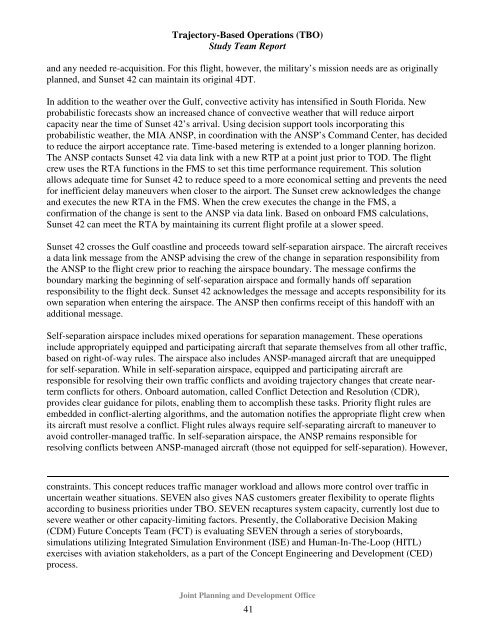Trajectory-Based Operations (TBO) - Joint Planning and ...
Trajectory-Based Operations (TBO) - Joint Planning and ...
Trajectory-Based Operations (TBO) - Joint Planning and ...
Create successful ePaper yourself
Turn your PDF publications into a flip-book with our unique Google optimized e-Paper software.
<strong>Trajectory</strong>-<strong>Based</strong> <strong>Operations</strong> (<strong>TBO</strong>)<br />
Study Team Report<br />
<strong>and</strong> any needed re-acquisition. For this flight, however, the military’s mission needs are as originally<br />
planned, <strong>and</strong> Sunset 42 can maintain its original 4DT.<br />
In addition to the weather over the Gulf, convective activity has intensified in South Florida. New<br />
probabilistic forecasts show an increased chance of convective weather that will reduce airport<br />
capacity near the time of Sunset 42’s arrival. Using decision support tools incorporating this<br />
probabilistic weather, the MIA ANSP, in coordination with the ANSP’s Comm<strong>and</strong> Center, has decided<br />
to reduce the airport acceptance rate. Time-based metering is extended to a longer planning horizon.<br />
The ANSP contacts Sunset 42 via data link with a new RTP at a point just prior to TOD. The flight<br />
crew uses the RTA functions in the FMS to set this time performance requirement. This solution<br />
allows adequate time for Sunset 42 to reduce speed to a more economical setting <strong>and</strong> prevents the need<br />
for inefficient delay maneuvers when closer to the airport. The Sunset crew acknowledges the change<br />
<strong>and</strong> executes the new RTA in the FMS. When the crew executes the change in the FMS, a<br />
confirmation of the change is sent to the ANSP via data link. <strong>Based</strong> on onboard FMS calculations,<br />
Sunset 42 can meet the RTA by maintaining its current flight profile at a slower speed.<br />
Sunset 42 crosses the Gulf coastline <strong>and</strong> proceeds toward self-separation airspace. The aircraft receives<br />
a data link message from the ANSP advising the crew of the change in separation responsibility from<br />
the ANSP to the flight crew prior to reaching the airspace boundary. The message confirms the<br />
boundary marking the beginning of self-separation airspace <strong>and</strong> formally h<strong>and</strong>s off separation<br />
responsibility to the flight deck. Sunset 42 acknowledges the message <strong>and</strong> accepts responsibility for its<br />
own separation when entering the airspace. The ANSP then confirms receipt of this h<strong>and</strong>off with an<br />
additional message.<br />
Self-separation airspace includes mixed operations for separation management. These operations<br />
include appropriately equipped <strong>and</strong> participating aircraft that separate themselves from all other traffic,<br />
based on right-of-way rules. The airspace also includes ANSP-managed aircraft that are unequipped<br />
for self-separation. While in self-separation airspace, equipped <strong>and</strong> participating aircraft are<br />
responsible for resolving their own traffic conflicts <strong>and</strong> avoiding trajectory changes that create nearterm<br />
conflicts for others. Onboard automation, called Conflict Detection <strong>and</strong> Resolution (CDR),<br />
provides clear guidance for pilots, enabling them to accomplish these tasks. Priority flight rules are<br />
embedded in conflict-alerting algorithms, <strong>and</strong> the automation notifies the appropriate flight crew when<br />
its aircraft must resolve a conflict. Flight rules always require self-separating aircraft to maneuver to<br />
avoid controller-managed traffic. In self-separation airspace, the ANSP remains responsible for<br />
resolving conflicts between ANSP-managed aircraft (those not equipped for self-separation). However,<br />
constraints. This concept reduces traffic manager workload <strong>and</strong> allows more control over traffic in<br />
uncertain weather situations. SEVEN also gives NAS customers greater flexibility to operate flights<br />
according to business priorities under <strong>TBO</strong>. SEVEN recaptures system capacity, currently lost due to<br />
severe weather or other capacity-limiting factors. Presently, the Collaborative Decision Making<br />
(CDM) Future Concepts Team (FCT) is evaluating SEVEN through a series of storyboards,<br />
simulations utilizing Integrated Simulation Environment (ISE) <strong>and</strong> Human-In-The-Loop (HITL)<br />
exercises with aviation stakeholders, as a part of the Concept Engineering <strong>and</strong> Development (CED)<br />
process.<br />
<strong>Joint</strong> <strong>Planning</strong> <strong>and</strong> Development Office<br />
41
















